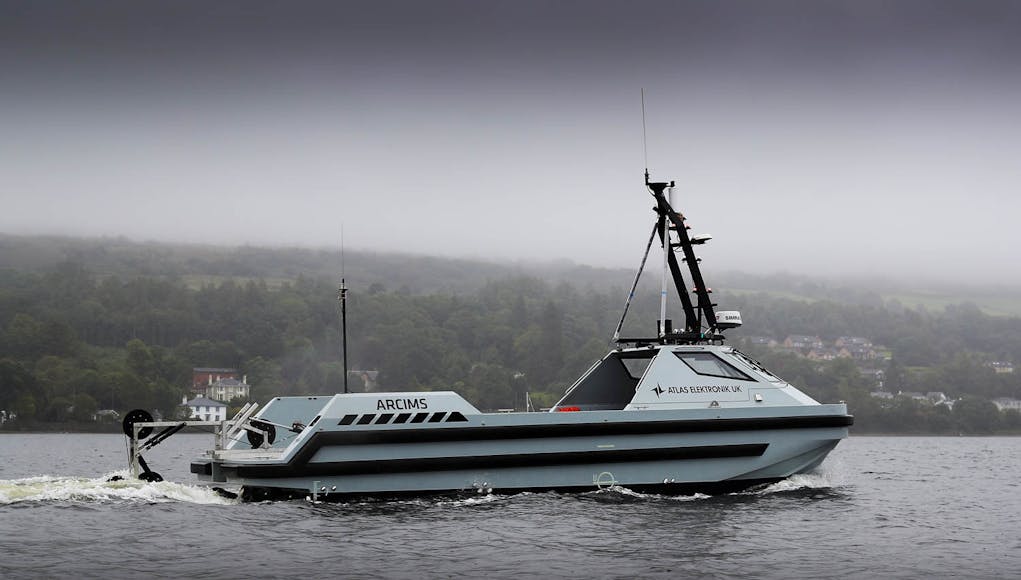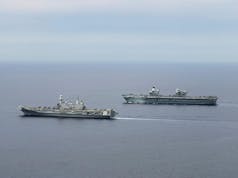Unmanned minehunting vessels will enter frontline service in March, say the Royal Navy.
Specialist autonomous kit, branded under the name ARCIMS, has now been handed over into military service and will be on live operations from March, according to this Royal Navy news release.
“Sailors trained in this of type mission will be stationed at HMNB Clyde, where the remotely operated kit, including submersibles and boats designed to hunt down mines but also analyse the oceans and sea floor, will be deployed from.
Initial operations are now being carried out by Project Wilton, the name for the Royal Navy’s unmanned mine hunting and survey endeavours. Wilton currently have three boats – two remote controlled and the other manned – as well as multiple underwater vehicles.”
According to an MoD statement:
“Collectively, they can search for, hunt and finally destroy mines faster than the Royal Navy’s Sandown and Hunt class ships, and they also have the added benefit of keeping the sailors required to operate them out of harm’s way. Modified versions of the same systems are also being looked at to carry out survey operations such as those performed by HMS Echo.”
The craft are not replacing currently in service vessels but are instead complementing them.
In 2016, ARCIMS took part in Exercise Unmanned Warrior in Scotland, when the Royal Navy invited Atlas Electronic UK to demonstrate its capabilities with more than 50 participants from the MoD, industry and academia.
ARCIMS reportedly demonstrated robust operations in varying sea states in several high-speed missions—acquiring and transmitting real-time towed sonar data to the command & control station for what’s called ‘in mission’ analysis. To date 10 vessels are in service or under contract say the manufacturer.
Back in 2018, the new system was tested again, this time against a number of performance requirements, for example, how well it cleared mines, whether the autonomous system could successfully avoid obstacles and the overall system performance.
Commodore Mike Knott, assistant chief of staff Maritime Capability, said in the news release:
“With equipment and personnel now operating on the Clyde, the transition to widespread use of autonomous systems in mine counter measures (MCM) is becoming a reality and places the Royal Navy MCM community at the cutting edge.”
The US Navy also operate unmanned minehunters. The Fleet class unmanned surface vessel, also called the Common Unmanned Surface Vessel, is a class of unmanned surface vessels designed for the United States Navy to be deployed from Freedom and Independence class littoral combat ships and is intended to conduct mine and anti-submarine warfare missions. The first was delivered to the US Navy in 2008.














My guess is that the next generation of ships to replace the Sandown and Hunt class ships will basically act as motherships for larger numbers of unmanned underwater minehunters.
Hi Steve,
I think this is where the modularity of the T26 and T31 will begin to shine. The fact that the T31 won’t have anything like a towed sonar array, will be offset by unmanned vehicles like these.
I see both of the new frigate types being great platforms for that. A long time to wait until the first new frigate hits the water, but by then we’ll have had plenty of testing time, getting familiar with unmanned vessels and generating a good set of operating procedures.
M@
I was thinking along the same lines. If I recall correctly, there was still a dedicated MCM/hydrographic replacement ship programme, but we haven’t heard anything about it in a while.
With T31, we could potentially replace the 13 dedicated MCMVs and possibly the two Echo-class survey ships with anywhere up to a dozen additional T31s (depending on budget allowances, but that would only require investment of roughly £2.5-3bn over the next decade).
Alternatively, a mixed force (my personal preference). Replace the 6 remaining Hunts with 3-4 T31s, and replace the 7 Sandowns and 2 Echos with a dozen cheap, GRP-hulled motherships that function as classic MCMVs but still using the drones. Result: a useful increase in escorts without losing the utility of plastic hulled minesweepers.
In either case, you could have 1-3 T31s permanently based in the Gulf. That would free up both the RFA mothership and an existing escort for use elsewhere.
A few comments:
1: I’m afraid the baseline Arrowhead 140 design cannot accomodate ARCIMS boats (~11.5m long) in their boat davits (up to 9.5m or so, can be easily “scaled” from CG on the web). This part shall be modified.
# T26 will be able to.
2: Drone-besed MCM system will be very expensive, by nature.
It has every sensor, analysis-kit, software and submersibles (=MCM kits) the Hunts have, and IN ADDITION, needs drone systems to deliver them. Maintenance load for the latter is ADDED to the original maintenance load for the MCM kits. It cannot be cheap.
Modern (classic-type) MCMV costs 150-200M GBP each now. So, budget prepared to replace 6 Hunts will be ~1000M GBP. As T31’s unit cost will be ~200M GBP (excluding initial+detailed design nor GFE), “3-4 T31” will eat 60-80% of the budget.
I do not think 6-units of “Drone-besed MCM systems” (if fully kitted as Hunt-class replacements) can be bought with the remaining money.
3: If the MCMV hull replacement is “simple hulls”, it can be cheap but large, because it is NOT built to frigate standard. Mix of such cheap mother ships (say, 8 of them), coupled with 12 full-MCM kits (added with 2 survey kits) will be my choice. The “remaining 6 kits” can be optionally deployed to
– normal PSVs in the market (lowest threat case = most of the MCM operations)
– or on T26 (and T31, if properly modified) (highest threat case)
I’m not sure if that is correct. Some of the images of T31 have ARCIMS in the boat bays.
A better capability to do the job is not ‘shrinking the navy’. We need to forget about counting hulls as a means of assessing capability. That’s not to say that we don’t need some more capability – we do. But the RN not a collection of toy boats, it’s a military force.
I would imagine that the fact that the UK has some of the roughest seas on the planet on its doorstep helps with testing. If a ship can withstand the North Sea during winter storms it’s a pretty well tested design and pretty capable anywhere.
I think it’d be a good idea if, while in unmanned operation, they flew a flag or symbol to identify themselves to other vessels. You wouldn’t want a trawler getting too close and cutting away a towed array, or worse dragging the usv under.
Yes it would be interesting to see if these will be completely autonomous or if they will be ‘man-in-the-loop’ systems with an operator watching on cameras.
M@
I would imagine there would be someone watching over them just in case someone decided to try and go for a joyride in it or otherwise steal it.
Yup, physical security would be something to think about but in this instance it would take a brave person to try and joyride on this system – it is MCM after all 🙂
Autonomous can cover a range of level of computer control as I am sure you are aware. Given the described range of missions in the article include survey I would have thought man-in-the-loop would at least be an option as survey cover a huge range of interest.
I wondered if there would not be some sort of over watch from a safe distance either directly or from another USV to give a more complete situational awareness especially when operating in coastal waters.
Interesting… an Aerial drone providing overwatch for several unmanned vessels. I like it (and it would probably be on-scene faster and more fuel efficient than a manned helo) But will these drones be more prone to electronic jamming being far from the relative cover of the frigate/mothership?
M@
Hi Matt,
Any vehicle, including missiles, that have a RF data link can in theory be ‘hacked’ or jammed. All you can do is make it as difficult as possible. In the case of a missile your time window to under take a hack is very small so probably better to focus on jamming, etc.
As for USV they are relatively slow and in this case would loiter in a given area for quite sometime, so I would hope their network defences are of the highest order.
Military networks are well defended but they are not invulnerable – nothing or very little can be.
To increase the resistance to jamming you would remove the omni-directional and replace it with a directional one that has a very narrow transmitted beam. This can be done with passive yagi style of aerial or an active aerial array. The other option is to use a laser as the communications device.
Whichever style you use the vehicle will still need to controlled via line of sight.
Much like the method the Iranians used to hack the US RG170 Sentinel drone which was being controlled via a satellite. If you ramp up the power of a transmitter operating on the same frequency, communications to the controller will be disrupted. The Iranians possibly managed to mimic the flight control communications, so managed to not only take over the drone but also to land it. The US has said it was a problem with the flight control software, which is bull as the aircraft didn’t crash. The transmitted data-link signal from the satellite will be quite weak, compared to a ground station. So there’s always a risk of hacking, especially if the drone is controlled via satellite and uses omni-directional aerials.
The Royal Australian Navy SOP for Autonomous Surface Vehicle (Drone boat) peacetime Ops is they are manned (safety number), but operate autonomously. If there is a safety/navigation issue etc, the safety number can take charge of the vessel.
We first used this type of system under an UOR after the last Gulf War, but the system was not taken into service after the job was done..! Such are Treasury Rules…
If you were to install a 30mm with Martlets onto them you could have quite a good counter against asymmetric swarming attacks if they were deployed from some form of mother ship unit
The USN has been using remote boats from RFA Cardigan Bay for some time during exercises. A large deck and big cranes make it ideal for a mother ship role.
With the RN boats being used in Faslane there are some wins for the system. The channels in and out of Faslane are probably the most route surveyed underwater area in the UK. If anything appears on the seabed that wasn’t there the last time it sticks out like the proverbial dogs bollock.
In a environment that has not had a route survey… Well things are going to be pretty much the same as using a regular MCMV. Hunt, classify and destroy, rinse and repeat.